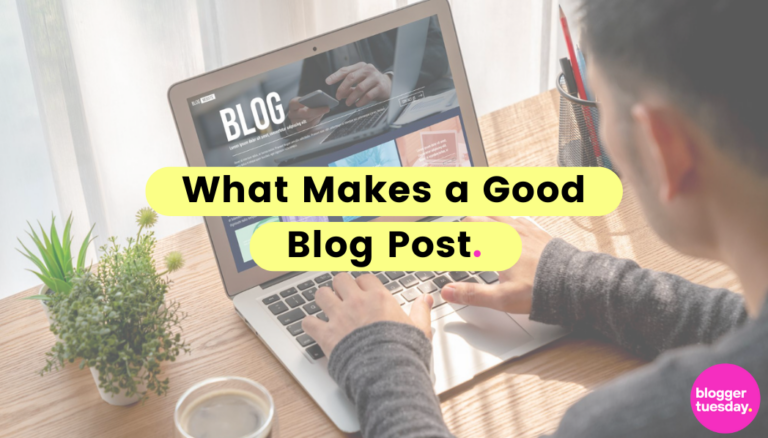Image by Gerd Altmann from Pixabay
Creating a successful blog post is an art and a science. If you are just getting started or are looking to refine your skills, then learning from experts and influencers will assist you with producing content that not only informs, but engages, and drives results.
From writing compelling content to measuring your post’s impact, this guide will help you craft high-quality blog posts that will resonate with readers.
Defining a Good Blog Post: Insights from Experts
What defines a ‘good’ blog post? Every niche and audience is different, but there are several characteristics that remain consistent right across the board. A successful blog post is one that is clear, informative, as well as relevant.
It should always speak directly to the reader’s needs. Their interests should also be considered as well. The bottom line is that the post should always deliver genuine value instead of filler content.
Structure is vital, so a well-organised post should include a:
- compelling headline
- Strong introduction
- logical flow
- satisfying conclusion
Proper formatting such as short paragraphs, bullet points, subheadings, as well as relevant links will improve readability and also make your posts a lot more accessible.
Tone also plays an important role too. While some blogs will adopt a formal or academic style, the most successful posts are usually conversational yet professional. It should feel as if the writer is speaking to a friend. This builds trust and rapport with your audience.
Top content strategist Ann Handley always emphasizes that blog posts must reflect the creator’s unique voice. She points out quite frequently that readers want fresh perspectives, supported by expert observations.
Brian Dean, who is the founder of Backlinko, has conducted research on blog post length. In a comprehensive study he analyzed over 912 million blog posts, Dean found that long-form content outperforms shorter articles in search engines, consistently. Needless to say, length is important.
Finally, a good blog post will take into account the user’s intent. It asks questions such as, Why is the reader here? What are they hoping to learn or achieve?
When you answer these questions thoroughly, it sets a strong foundation for the creation of effective content.
Crafting Engaging Content: What Top Influencers Do
Top influencers understand that it is not enough to simply share information, you must also tell a story. Even if the post is about something technical such as SEO or even financial planning, they know how to keep the reader interested.
An engaging post will usually begin with a very strong hook, it could be a surprising statistic, a relatable question, or just a personal story. This will draw the reader in and encourage them to keep scrolling through your content.
Influencers also know how to write in a voice that sounds authentic to their brand. Whether it is witty, warm, or just deeply insightful, the tone must stay consistent and build a strongly recognisable identity over the course of time.
Language matters too. Great writers often try to avoid jargon unless absolutely necessary. It is best to explain complex ideas in simple terms.
They use rhetorical questions, analogies, as well as storytelling techniques to maintain interest. Calls to action (CTAs) should be placed strategically; this will invite readers to comment, share, or simply take a specific next step.
Influencers also focus on the reader, not themselves. Rather than broadcasting their own experiences, they try to connect everything back to what the reader can learn or apply to their own situation.
Choosing the Right Visuals to Enhance Your Message
Visuals are no longer just optional, they have become essential. Whether you are using a featured image, infographic, chart, or just a GIF.
A well-chosen visual will help to explain ideas, break up your text, and also enhance the overall appeal of your post.
You should ensure they are carefully selecting visuals that match your brand style. For example, a travel blogger may use lush, high-resolution landscape photos, a tech blogger on the other hand may opt for clean charts and UI screenshots.
These visuals don’t just look nice—they will also serve a purpose. Infographics will condense complex information and step-by-step screenshots will guide readers through different processes. Illustrations will add creativity and clarity.
Accessibility should also be considered. British bloggers and influencers are now increasingly aware of the importance of using alt text for images.
This ensures that visually impaired readers can access their content through screen readers. Moreover, descriptive filenames in addition to optimised image sizes will help boost SEO and reduce your page load times.
Canva, Adobe Express, and PowerPoint are all popular tools for creating visual content. However, even a well-placed image downloaded from Unsplash or Pexels will dramatically improve your post’s appearance as long as it is relevant and adds context.
Optimising for SEO: Keywords and Beyond
Search engine optimisation (SEO) is vital for visibility. However, it goes way beyond sprinkling keywords throughout your post. Modern SEO is all about creating valuable, and user-friendly content that search engines can easily understand and rank.
Influencers must begin with keyword research. They use tools like Ubersuggest, SEMrush, or Ahrefs to help find terms their target audience is actively searching for. These keywords are then incorporated naturally into the headline, and subheadings. They are also places in the introductory paragraph, meta description, and image alt tags.
However, good SEO is also about user experience as well. Readability truly matters. Posts should load quickly, and be mobile-responsive.
They must also have clean URLs. Internal linking helps to keep readers on your site, while external links to credible sources will build trust and context so be sure to use them.
Long-form content is usually over 1,200 words and it tends to rank better, provided it offers depth as well as structure. You can also repurpose and update old blog posts so that they can maintain relevance. This is especially important if Google’s algorithms or industry standards have changed.
Technical SEO such as site speed and structured data will often fall to web developers, but content creators must try to understand the basics in order to work effectively with their platforms.
Promoting Your Blog Post: Strategies That Work
Even the most brilliant of blog posts won’t succeed without some promotion. Influencers who succeed know that distribution is just as important as creation. Once a post gets published, the real work begins.
Social media is a primary channel for distribution. LinkedIn, Twitter (X), Instagram, and Pinterest are all very effective depending on your niche. But promotion doesn’t mean posting once and then just moving on. Successful influencers will schedule multiple variations of their post. They will also use storytelling in their captions, and engage with comments to help to boost reach.
Email newsletters are yet another powerful tool. Loyal readers are far much more likely to click and engage with any new content you.produce. Some bloggers will tease the topic with a question or insight in the email, and then link to the full post for more.
Influencers also collaborate. They do this through guest posts, by tagging others mentioned in their article, or by participating in content roundups. These tactics will help build backlinks while introducing your blog to new audiences.
Paid promotions, such as boosted posts or Google Ads, can be useful as well but only if they are well-targeted and backed up by high-quality content.
Measuring Success: Metrics Influencers Monitor
What is measured gets improved. Influencers are able to track a variety of metrics to determine how well a blog post is currently performing. It is not just vanity numbers, but indicators that are able to reflect genuine engagement.
Key metrics include:
- Page views: This is how many people saw the post.
- Average time on page: Did visitors stay long enough to read the post?
- Bounce rate: Did your visitors leave immediately or did they continue exploring your site?
- Click-through rate (CTR): Did the readers click on internal or external links, while on the website?
- Social shares and comments: Is the content from the post being discussed and passed around on various platforms?
- Conversions: Did the post lead to lots of email sign-ups, purchases, or any other desired actions?
Tools like Google Analytics, Hotjar, as well as Search Console are commonly used. Influencers will then use this data not just to report on current performance but to inform their future strategy.
A post that performs well might spark a series or videos by the influencer, while one that underperforms will generally be rewritten or repurposed.
Continuous Improvement: Learning from Feedback
Always remember that no blog post is ever really finished. Influencers believe in continuous improvement. This is in terms of individual posts and overall content strategy.
Reader feedback is also an invaluable resource as well. Comments, emails, and even DMs will offer insights into what people liked from you and what they didn’t. Influencers pay attention to which topics will start generating conversation, which formats perform best, also what content gaps exist.
They also revisit old posts in order to update facts, refresh examples, and also to refine language. This keeps their blogs very current and competitive, especially if they are in fast-changing industries such as tech, marketing, or health.
Analysing competitors is another tactic. Look at what others in your space are doing well. Consider if you can offer a deeper take, a fresh perspective, or even a different format such as a case study or downloadable guide.
Improvement also comes from simply practicing. Make sure you are writing regularly, reading widely, and also experimenting with formats. Try everything from listicles to interviews. This helps you to evolve as a content creator.
Get Started: Create Your Own Successful Blog Post Today
The journey to writing a successful blog post begins when you make that first single draft. Whether you’re aiming to educate, entertain, or simply convert, the key lies in knowing your audience, and delivering value.
You must stay consistent with this. You also need to embrace authenticity, effort, and have a willingness to learn.


